May 2006
The First Head-Fi National Meet
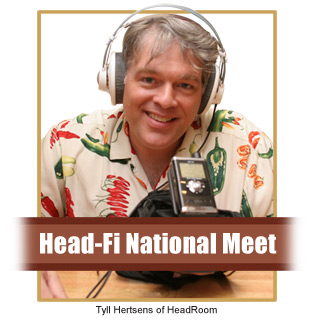 If you have any doubts that
headphone listeners can’t be as enthusiastic and fanatical as any other audio buffs,
a visit to the first Head-Fi National Meet held in Bayside, NY April 22 and 23 would have
dispelled them. For those unfamiliar with the Head-Fi organization that sponsored the
meet, it’s an online forum (www.head-fi.org)
where any and all facets of headphone listening are open for discussion. Unlike a lot of
online audio forums, Head-Fi is largely free from "flames," those abusive
personal attacks on people whose opinions differ from the attacker’s, that sometimes
make online discourse downright unpleasant. And Head-Fi is cordial to the newbie who is
just starting to become interested in headphones.
If you have any doubts that
headphone listeners can’t be as enthusiastic and fanatical as any other audio buffs,
a visit to the first Head-Fi National Meet held in Bayside, NY April 22 and 23 would have
dispelled them. For those unfamiliar with the Head-Fi organization that sponsored the
meet, it’s an online forum (www.head-fi.org)
where any and all facets of headphone listening are open for discussion. Unlike a lot of
online audio forums, Head-Fi is largely free from "flames," those abusive
personal attacks on people whose opinions differ from the attacker’s, that sometimes
make online discourse downright unpleasant. And Head-Fi is cordial to the newbie who is
just starting to become interested in headphones.
Held at the Adria Hotel Conference Center, the
event was attended by an estimated 270 members and several manufacturers and dealers. A
Head-Fi meet is rather different from a standard trade show. Head-Fi members bring their
systems -- a collection of headphones, amplifiers, source components, cables and the like
-- and set them up so other members can drop by and sample their sound. If you want to
hear how headphone X sounds with amplifier Y, just find someone with those components, ask
the owner’s permission to borrow the headphones, take them to the amplifier location,
and listen to your heart’s content. This way, you have an unparalleled opportunity to
hear just the combination of ‘phones and amp you’re curious about. Only the
portability of headphones and headphone amps makes this approach possible, and only the
open, generous nature of the headphone community makes it work.
Although the Head-Fi community is international
(it’s a creature of the Internet), until now there has never been a national US meet.
There have been lots of meets, but they’ve been regional, so members don’t have
to travel long distances to share their love of ‘phones with others. But Aaron
Kovics, who also writes about headphones, led a team of Head-Fi members to organize this
first national meet.
Unlike with most of the regional meets, there was
a strong manufacturer/retailer presence at Bayside, including Grado Labs, HeadRoom,
Singlepower Audio, Ultimate Ears, Slappa, Ray Samuels Audio, Moon Audio, Shure, Todd the
Vinyl Junkie, RudiStor Sound Systems, AAA Audio, Westone, Audio Technica, Beyerdynamic,
AKG, Sennheiser, and several others. Most of the manufacturers didn’t just show up;
they donated products for a fund-raising raffle, and contributed directly to help fund the
meet. Unlike typical trade shows, many manufacturers brought samples of their products to
let Head-Fi members try in their systems; all the members had to do was sign out the
equipment and return it. Most manufacturers also had deeply discounted show prices for the
Head-Fi members who attended.
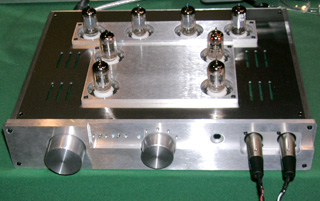
Prototype of Ray Samuels Audio's B-52 headphone amp.
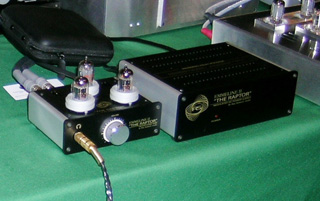
Ray Samuels Audio's "Raptors."
|
An interesting characteristic of a
Head-Fi meet is that it tends to be, well, messy. Owners set up their systems and then go
off to search for something new to listen to. Passers-by stop, sample a system, and then
move on to the next interesting system. By the middle of the day, things get pretty
random. Also, the systems aren’t labeled, nor are the owners listed on the tables. So
it’s sometimes rather hard to find an owner to get details about a given system.
Nevertheless, there were some intriguing systems belonging to owners. Another
characteristic of the meet was its high ambient noise level. You might think this is not
important; after all, we’re listening to headphones. But most headphones are the
open-back type, which let lots of outside sound reach the listener, and the noise level
was high enough that it often intruded, even with headphones on one’s head.
Ray Samuels Audio's table was the only one to
feature LPs as a major source. Of course, Ray was also one of the only manufacturers
present making phono stages (he used his $4500 Emmeline XR-10B phono preamp for the meet),
so his fondness for vinyl is understandable. In addition to Ray’s usual lineup of
headphone amps (both solid state and tube), he showed a prototype of a new model called
the B-52 (price not yet set). A fully balanced preamp as well as a headphone amp, the B-52
has both balanced and single-ended inputs and outputs, and sports a balanced, tubed
output-transformerless headphone output. This means most headphones will need to be
recabled, or at least reterminated, to work with the B-52; however, it sounded well worth
the trouble. The B-52 has two balanced inputs, three unbalanced inputs, a tape output, and
both balanced and single-ended outputs. A massive dual-mono power supply was also part of
the package. Ray also showed his $875 solid-state HR-2 and $1175 tubed Raptor tabletop
headphone amps, and the $2495 Stealth tubed headphone amp/preamp. Also on display was the
tiny solid-state Hornet headphone amp, whose rechargeable battery makes it perfect for use
with iPods or other portable players. The $350 Hornet was available in a variety of
colors, including red, blue, gold, silver, and black.
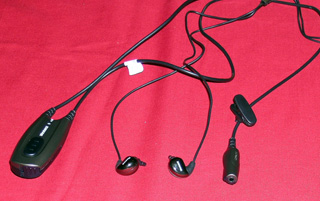
Shure's E500 earphones.
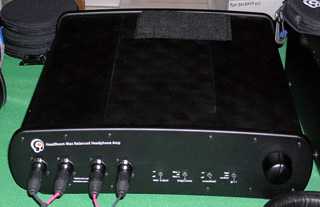
Headroom's $5000 Max is a fully balanced headphone
amplifier.
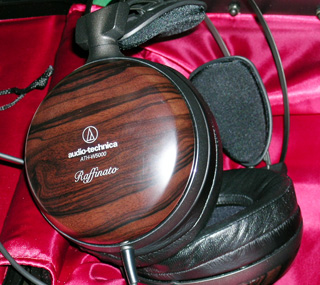
Audio Technica's ATH-W5000 heaphones with zebra-wood
earcups.
|
Shure gave us a preview of its
soon-to-be-released E500 earphones. Somehow Shure managed to shoehorn three drivers into
this in-the-ear ‘phone, although the unit is a two-way design. Two of the drivers
handle the bass range, while the other handles the treble. Shure’s Matt Engstrom told
me that a cloth insert in front of the treble driver helped control the highs. I was
impressed at the E500’s smoothness and detail, characteristics I don’t often
hear in earphones. A push-to-hear control switch mutes the music and connects a microphone
to the earphones so you can hear what’s going on around you. That’s a very
useful feature for earphones that provide 30-37dB of isolation from outside sounds.
Available this summer, the E500 will sell for $499.
HeadRoom showed several of its amplifiers,
including a $5000 Max balanced unit, which drove recabled AKG K701 headphones with great
authority and smoothness. Descending to a price range I could handle, the $649 hybrid
Millett amp drove standard K701s superbly. The Millett is from HeadRoom’s Desktop
line, which spans the price range from $600 to $2000. One of the Head-Fi member systems
used the same components (with HeadRoom’s external supply), driven by an
Exemplar-modified Denon DVD-2900 for a splendid sound. HeadRoom’s Tyll Hertsens
played a major part in organizing and making arrangements for the meet.
Although Audio Technica didn’t attend the
meet, the products they sent were quite interesting. An ATH-W5000 headphone looked great
with its striking zebra-wood earcups and sounded smooth and detailed. It sells for
$800-$900.
Beyerdynamic had its new-for-2006 DT 880
($489) and DT 990 Pro ($559) headphones on display. The DT 880 had a largely
cosmetic restyling, and now features a more curved earcup. Sonically, it’s not much
different than the previous model. The DT 990 has been extensively updated, and
features a stylish louvered back that looked great. As before, the DT 880 still had a
more extended high end (some would describe it as bright), while the DT 990 had a
more relaxed sound.
From Germany, Ultrasone’s wide lineup of
headphones all featured a common design: the driver is located off-center in the earcup
(it’s actually below the center of the cup). This gave all the Ultrasone ‘phones
a rather spacious sound and reduced the overall sound pressure. I sampled several models
and found the rather diffuse sound pleasant, but not quite the same as spacious-sounding
speakers. There were two lines of Ultrasone headphones: the PROline and the HFI line. They
all use the same drivers, although construction details differ. The lower-priced units use
a Mylar diaphragm, the mid-priced units use a gold diaphragm, and the top-of-the-line
units use a titanium diaphragm. Unlike many of today’s headphones, Ultrasone 'phones
have closed backs, providing better isolation from outside noise. This makes them
particularly well suited for onsite monitoring of recording sessions. All Ultrasone
headphones are shielded to reduce radiation. I wasn’t aware that headphones emitted
radiation and would like to see some documentation of that claim.
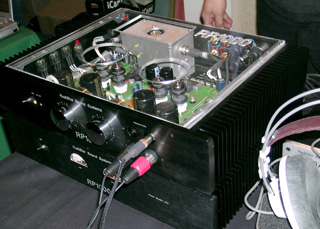
RudiStor's fully balanced RP1000 headphone amp.
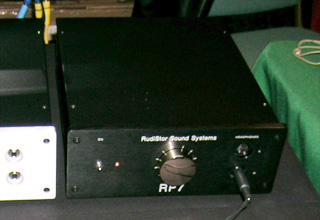
RudiStor's RP7 Lite.

Sennheiser's display.
|
From Italy, Dr. Rudi Stor of the
aptly named RudiStor company showed his impressive RP1000 headphone amp. This massive,
hybrid, fully balanced amp uses 12AU7 tubes along with a solid-state output stage. The
external power supply uses a shielded constant-current generator. Unusually, users can set
the bias of the output tubes with built-in digital meters -- a very nice touch. Price is
€10,000 (about $12,400). Also shown was the RP7 Lite amplifier, which uses
cryogenically treated 12AU7 tubes in an unbalanced configuration and sells for $1650. The
$850 hybrid RP5.1 (reviewed on SoundStage!) was also shown. The $720 NKK02
amplifier is also a hybrid design that uses 12AU7 tubes.
Westone displayed two tiny earphones. The $109
UM1 uses a single driver, while the $299 UM2 has two drivers. These ‘phones worked
well with iPods. Both were quite listenable, but the UM2 had a wider range.
Another company that makes earphones is Ultimate
Ears. I auditioned the $250 Super.Fi 5 Pro, a two-way model, and the decidedly upscale
$900 UE 10 Pro. I thought the latter had good bass and a bright, open sound. Ultimate Ears
makes custom earphones and can furnish earplugs individually tailored to your ear canal.
They even had an audiologist at the show creating custom ear plugs for customers.
Sennheiser is one of the most popular headphone
brands, and deservedly so. They showed their standard lineup of headphones, still topped
by the $550 HD 650. I learned that they are working on a successor to the
HD 650, but no details were available. Sennheiser’s house sound (a very relaxed
high end and strong, deep bass) is not my cup of tea, but that’s just a case of
personal preference, partly driven by my musical tastes (or lack thereof!).
AKG showed the new K701 ($399) and K601 ($299)
‘phones. AKG’s representative observed that the importer had not had much
experience with the K701s because every unit imported was already sold. This was my first
experience with the K601, and while it’s not the equal of the K701, it’s clearly
cut from the same cloth.
If anyone knows about making earphones, it’s
Etymotic Research. Their clever display featured a dummy head with microphones inside at
the ear positions. The microphones picked up the room noise (which was quite substantial)
and then piped it to a set of Etymotic 4B earphones. By removing the earphones, you could
directly compare the sound of the room through the earphones to live sound. There
wasn’t much difference at all. Other models in the 4-series include the 4S, which
rolls off the highs to sound more like speakers, and the 4P, which is more sensitive
(think iPod). All 4-series earphones sell for $330. I wonder how they sound with music.
AAA Audio was a new company to me. Importer Ping
Gong showed several products from the Original Electronics brand, and all appeared to be
bargain priced. The Original Master headphone amp included a separate power supply (in its
own aluminum case) and looked like a super-bargain at only $198. The Leonardo CD-A9.3
fully balanced tube CD player topped the line at $1998 and used a top-loading transport in
a stunning chassis. A round metal remote control was included. This player looked like it
should cost $10,000. Downscale a bit was the CD-2008 Mk II CD player, a solid-state design
with its own striking casework reminiscent of Simaudio products (except it was silver, not
black). This $898 player upsamples to 24-bits/192kHz. A more conventionally styled CD
player, the $698 CD-A8T uses a hybrid circuit.
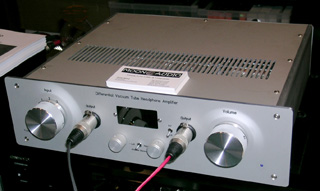
Moon Audio's Luna is priced from $2200-$3300 depending
on options.
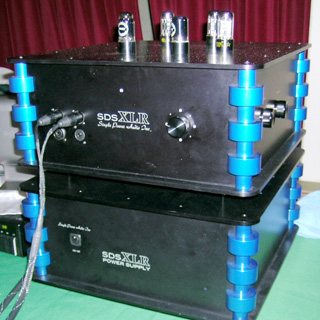
Singlepower Audio's massive SDS XLR.
|
Another company I hadn’t
encountered was Moon Audio. They displayed the Luna differential vacuum-tube headphone
amplifier, which also serves as a line stage with both balanced and unbalanced inputs and
outputs. Pricing ranges from $2200 to $3300 depending on the options chosen. It uses
premium parts throughout. Oh, yes, the amp is not actually named Luna; that’s
a temporary designation which will be replaced soon.
Mikhail Rotenberg’s Singlepower Audio makes
some of the most exotic headphone amplifiers you’ll find, and he went all out with
his display. A massive SDS XLR amplifier, with an equally massive matching power supply,
was larger than many power amps. The base cost of the SDS XLR is $10,000, while the model
shown cost $15,500. Somewhat cheaper was the Maestro Aurum XLR, with a base price of
$8000. The gorgeous gold-plated unit on display sold for $12,000. But my favorite
Singlepower unit was the ES1 amp designed to drive electrostatic headphones. Through
Sennheiser HE90 ‘phones, the sound was perhaps the most direct (i.e., free
from distortion and unnatural artifacts) I have ever heard from any transducer. Closer to
my price range, the $899 PPX3 Slam amplifier drove standard headphones with lots of power
and dynamics. All the Singlepower amps are highly customizable, so you can tailor one to
suit you ears and your budget. And they all use tubes exclusively. They can inspire major
audiophile lust.
Manufacturers weren’t the only ones with
interesting equipment to display. The mint Sennheiser Orpheus headphone system (amp and
‘phones) as part of Tom Bozebuttons’ setup represented the Holy Grail of
headphone listening for many aficionados, and a quick listen showed why. Smooth, detailed,
and realistic, the Orpheus caressed the ear with great music. Of course, Tom’s source
equipment (EMM Labs CDSD transport and DAC 6e DAC) was up to the Orpheus’s standard.
Another member system that caught my eye and ear
featured a Duality dual-mono amplifier designed and built by Blackie Pagano. This is a
full-fledged integrated amplifier with speaker connections as well as a headphone jack.
Built on two copper-colored chassis (one was a completely dual-mono power supply), the
Duality used 300B output tubes for a gloriously open and clear sound.
There were many other user systems on display,
some featuring home-brew amplifiers and cables. I noted a couple of interesting trends.
One was the relatively large number of systems that used computers as sources, and the
other was a relatively large number of amplifiers that used balanced outputs. I suspect
we’ll be seeing more of these technologies.
In the evening, the attendees performed headphone
lovers’ second- and third-favorite activities: eating and talking about headphones.
Later, a panel of headphone designers fielded questions from Head-Fi members. The panel
responded to questions ranging from "What is your personal headphone system?" to
"How can I get a job in the headphone industry?" The most common answer to the
latter was "Get an engineering degree."
Everyone I talked to expressed great satisfaction
with the results of the meet. So will there be a Second Head-Fi National Meet next year?
Although arrangements weren’t final, it’s possible that next year’s
get-together will be held in San Diego. Check out the Head-Fi forum for the latest
information.
...Vade Forrester
vade@soundstage.com